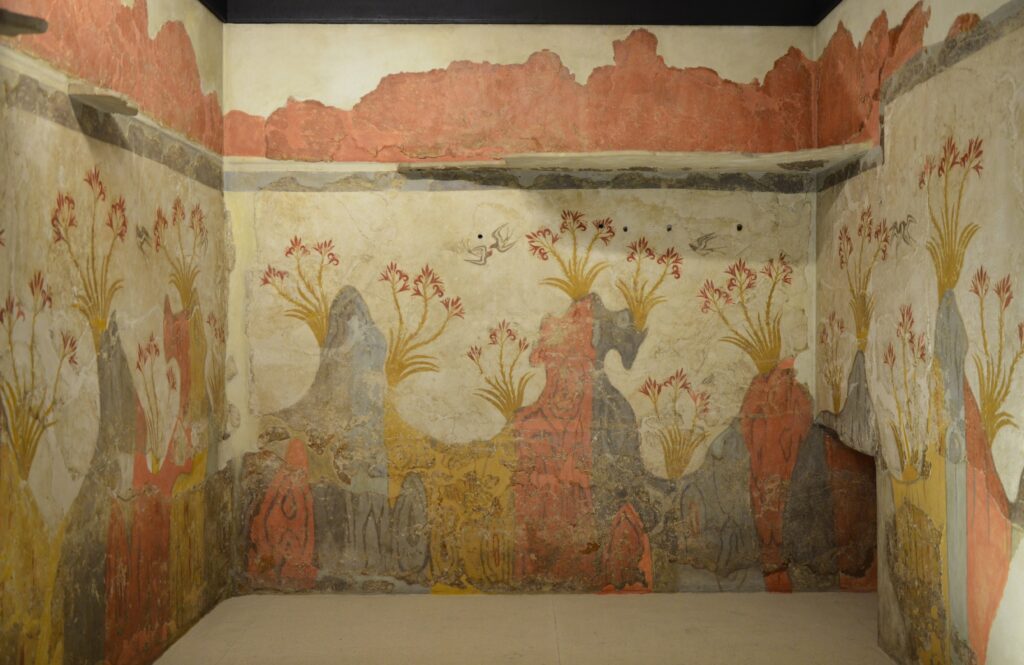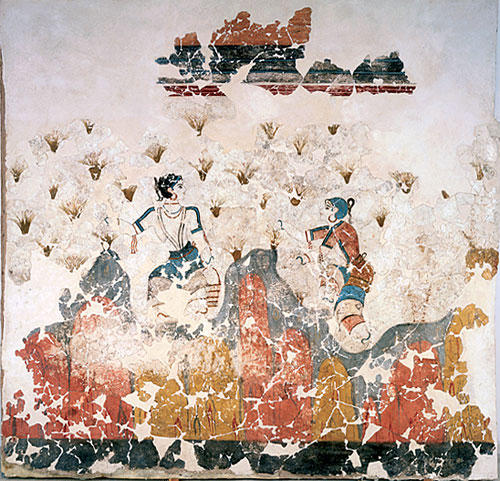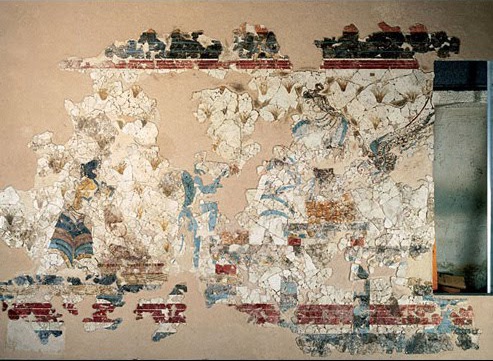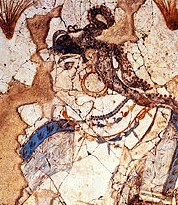Generally, the theme of girlhood in ancient Greek art is… well…. somewhat non-existent. Save from the odd vase painting of Iphigenia (a young girl sacrificed to the gods by her father… Great!), the general view of femininity we are granted in Greek art is mythic queens, powerful goddesses, and rich women, immortalised by their husbands in the form of grave steles. In short, we are not granted anything that resembles ourselves, or our own experience of girlhood or womanhood.
However, thousands of years before the classical Greeks that we traditionally think of, there were the Minoans: the Minoans existed over a thousand years before the Classical Greeks, roughly between 3650-1400 BCE. Relatively little is known about Minoan society in comparison to their classical counterparts, especially in regards to myth and religion: whereas with Classical Greeks there are hundreds of named figures, such as Zeus, Athena, etc. we simply do not have this same level of knowledge in regards to Minoan mythical figures. One of our greatest clues as to Minoan culture is indicated in the surviving examples of art that we have, such as vases, sculptures, and the focus of this blog: frescoes.

Frescoes are paintings done on walls or ceilings of buildings, in a manner that allows the paint to dry into the plaster of the wall itself. There are several surviving frescoes from the Minoan period recovered from buildings and houses. They are extremely striking due to their use of bright primary colours, ethereal vegetation, and, occasionally, vibrant mythical creatures. Al the frescoes I am discussing in this post were found in Akrotiri, a small village in Santorini.
What strikes me about Minoan frescoes, however, is the presentation of girls and women. Not only are they present, but they are often depicted as constructive members of society, free from the male gaze, rather than forlornly clinging to the sides of their mothers. What’s more, they are seen as having active roles as opposed to passively existing under masculine desire and ownership.

For example, this fresco, The Saffron Gatherers (otherwise known as The Crocus Gatherers), depicts a young girl (right), alongside a slightly older girl/young woman (left). As you might have gathered from this fresco’s rather explanatory title, these two figures are depicted as collecting the spice saffron from crocus flowers. Not only does this fresco depict girls as being active and productive, but, what’s more, they are performing a task that requires skill, and a large degree of trust and importance. The process of collecting saffron from crocus flowers is infamously an extremely delicate and difficult process, which still to this day is performed by hand. The intricacy of this laborious process means even to this day, saffron is worth more than its weight in gold!
Whereas women in art throughout history are often presented in stagnant and unmoving positions (as if to be taken in by the viewer) both of the girls in this fresco are presented in active and ‘unfeminine’ positions, where their bodies are not painted to be at their most flattering angle, with the girl on the right actively leaning her body away from the viewer. Additionally, both of these girls are fully clothed with realistic body types, engaging in joyful conversation as they work. Seeing young girls being depicted with such vibrancy is beyond refreshing.

The fresco on the adjoining wall to where The Saffron Gatherers was found also gives the task of gathering saffron the implication of religious importance. This fresco has been referred to by archaeologists as The Mistress of Animals, or else The Saffron Goddess. On the left hand side, a young girl, just like the one depicted in The Saffron Gatherers appears to be depositing a basket of saffron into a pile. She looks eagerly towards the figure at the far right of the fresco, a tall and beautiful woman sitting on a pile of cushions, with a mythical bird-like creature to her right. A monkey-like figure is offering something to the seated woman.
Upon viewing this fresco, it is immediately noticeable that all the figures are turned towards the seated woman, thus making her immediately noticeable to the viewer, too. Upon further inspection, we can see that, although the figure is seated, she would be inhumanly tall in comparison to the girl and monkey figure if she were to stand up. It is because of this height and this implied importance that ancient historians believe this figure to be a goddess, hence the alternate title of this fresco of The Saffron Goddess.

Not only is this tall, beautiful, and powerful being a wonderful example of female representation, but it is equally empowering to see the young girl depicted as part of this scene. It is so rare in modern art that we see young girls playing important and meaningful roles, yet here we see this girl not only acting in a religious ritual, but being important enough to be entrusted in the presence of a goddess. Her bright other-worldly clothing and eager smile truly make her a captivating and inspiring presentation of girlhood.
These are just two of many Minoan frescoes depicting girls and young women in a beautiful, inspiring, or meaningful light. I believe these frescoes in particular are the kind of art that every young girl should see, and use to admire their brightly-coloured historical counterparts. Attached below is a list of links to other Minoan frescoes depicting young girls or women in an interesting, productive, or empowering light. I definitely encourage any reader to delve further into the frescoes uncovered throughout Greece, and, thus, the world of this culture’s beautiful artwork.
-Izzie Heis
Junior Girl
Girl Museum Inc.
More frescoes to discover and discuss:
Woman or goddess (“La Parisienne”) from the Camp-Stool fresco, c.1350 B.C.E. discovered at the palace at Knossos, Crete-https://smarthistory.org/la-parisienne/ https://www.flickr.com/photos/49503110044@N01/84597425
‘Ladies in Blue’ Fresco- c.1525-1450B.C.E discovered at the palace at Knossos, Crete- https://joyofmuseums.com/museums/europe/greece-museums/heraklion-crete/heraklion-archaeological-museum/ladies-in-blue-minoan-fresco/https://commons.wikimedia.org/wiki/File:Ladies_in_Blue_fresco.jpg
Camp stool Fresco The Camp Stool fresco (reconstruction), c. 1350 B.C.E., from west wing of the palace of Knossos, Crete-https://commons.wikimedia.org/wiki/File:Camp-stool_Fresco,_Minoan,_from_Knossos,_AMH,_145371.jpghttps://smarthistory.org/la-parisienne/
